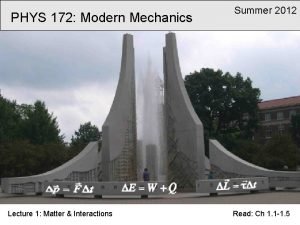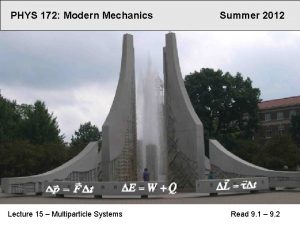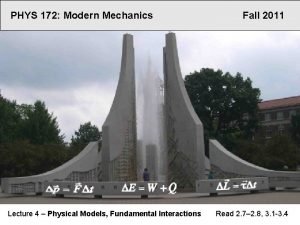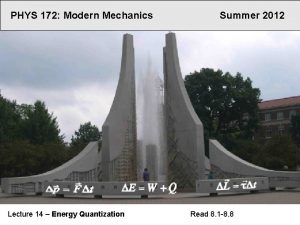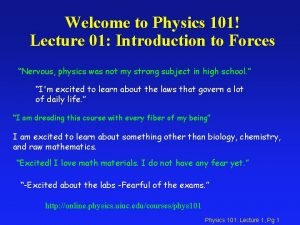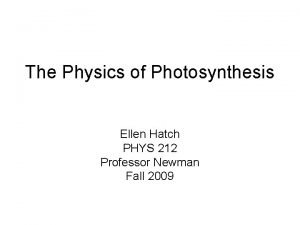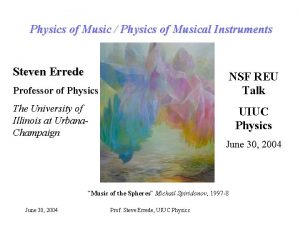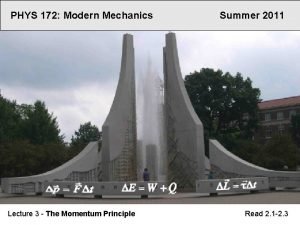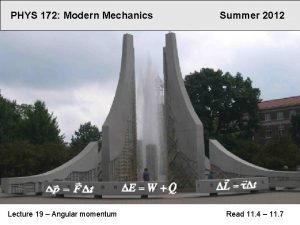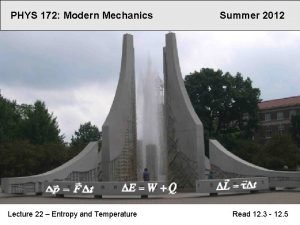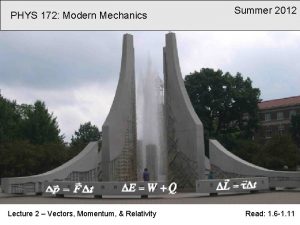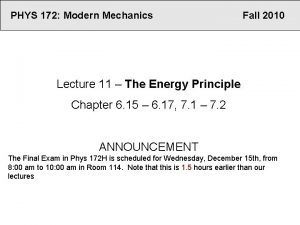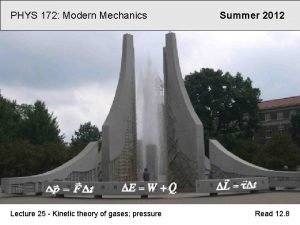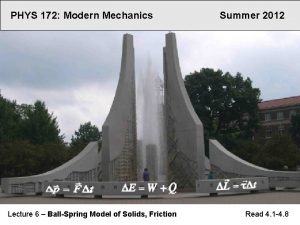PHYS 172 Modern Mechanics Lecture 16 Multiparticle Systems














- Slides: 14

PHYS 172: Modern Mechanics Lecture 16 – Multiparticle Systems, Moment of Inertia Summer 2012 Read 9. 3 – 9. 5

Rotational Kinetic Energy • Consider a rigid system rotating on an axis • All atoms are rotating at the same “angular speed”

Moment of Inertia

Some Moments of Inertia

Rigid Rotation about a Point Not the Center of Mass In General In this case What is Ktrans?

What is Ktrans?

Point particle system For both, real and point system: Point particle system: See derivation in the book

Application: Jumping up Point particle system: Real system: FN is pushing your feet which do not move! No work is done… Difference: point particle does not change shape

Application: Stretching a spring Real system: Point particle system: In real system: each force does work, involves displacement of the point to which the force is applied

Example: hockey pucks d 1 d 2

Example: a box containing a spring b cm sticky s System: Ball with mass mball Box with mass mbox<<mball Spring – massless M = mball a) How fast will the ball move immediately after it sticks to a box? a b) What is the increase in thermal energy of the ball? assume Q=0

Clicker question 1 1 Wheel 1 of mass M rolls down from a slope. Wheel 2 of the same mass M slides down from the same slope (ignore friction) Which wheel will acquire larger total kinetic energy? 2 A) Wheel 1 (rolling) B) Wheel 2 (sliding) C) The same

Clicker question 2 1 Wheel 1 of mass M rolls down from a slope. Wheel 2 of the same mass M slides down from the same slope (ignore friction) Which wheel will acquire larger translational kinetic energy? 2 A) Wheel 1 (rolling) B) Wheel 2 (sliding) C) The same

Clicker question 3 1 Wheel 1 of mass M rolls down a slope. Wheel 2 of the same mass M slides down the same slope (ignore friction) Which of the wheels will get down first? 2 A) Wheel 1 (rolling) B) Wheel 2 (sliding) C) Both will get down in the same time
 Phys 172
Phys 172 Particl clicker
Particl clicker Iterative prediction of motion
Iterative prediction of motion Phys 172
Phys 172 172+172+283+283
172+172+283+283 Physics 241 purdue
Physics 241 purdue 01:640:244 lecture notes - lecture 15: plat, idah, farad
01:640:244 lecture notes - lecture 15: plat, idah, farad Physics 102 uiuc
Physics 102 uiuc Physics 101 uiuc
Physics 101 uiuc Phys courses ucsd
Phys courses ucsd How to calculate the percent difference
How to calculate the percent difference Single slit envelope
Single slit envelope Http //www.phys.hawaii.edu/ teb/optics/java/slitdiffr/
Http //www.phys.hawaii.edu/ teb/optics/java/slitdiffr/ Phys 212 equation sheet
Phys 212 equation sheet Phys 398 uiuc
Phys 398 uiuc
